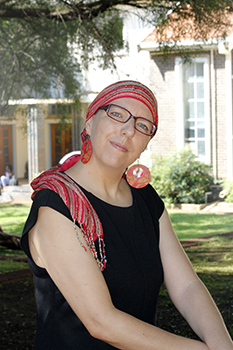
Michelle Nöthling, master’s degree student
in the Centre for Trauma, Forgiveness, and
Reconciliation Studies at the UFS.
Photo: Eugene Seegers
From 7 April to 15 July 1994, a mass genocide swept through Rwanda after years of Belgian colonial rule that divided the country along ethnic lines. Rape was also used as part of a political strategy to torture and humiliate mainly Tutsi women, and as a means of spreading HIV.
Individual focus
Why is it important to listen to what these rape survivors have to say? Michelle Nöthling, a master’s student in the UFS Centre for Trauma, Forgiveness, and Reconciliation Studies, responds, “We speak of groups – refugees, foreigners, and the like – yet we tend to forget the individuals and the lasting impact trauma has had on each person.”
Narrative exploration
Michelle maintains that we are the product of the narratives around us; things like – how to be a woman, how to dress, speak, or treat others. Her research delves into how these rape survivors see themselves, how they narrate their lives. She also investigates power relations based on gender; for example, how language can be used as a divisive tool.
Rwandan backdrop
In Rwanda, gender roles are deeply entrenched. Traditionally, a ‘girl’ remains such while she is a virgin. Her transition into womanhood is usually marked by marriage and followed by motherhood. But rape disrupts this structure, leading to an identity crisis as these girls are catapulted into motherhood with an unplanned child resulting from a traumatic event.
“We are the product of
the narratives around us.”
Reaching their mid-teens, the children, too, started asking questions about identity or paternity. For those mothers who were finally able to open up to their children, the experience has been mostly liberating – often leading to a closer relationship between parent and child. Michelle intends to interrogate how such significant moments shape the way these women perceive themselves. Research tends to portray these survivors solely as mothers of rape-born children. Michelle, however, seeks to examine their identities more deeply.
“These survivors still bear the heavy burden of being marginalised, stigmatised, and severely humiliated. Despite this, they have developed their own communities of belonging; people with whom they connect, to whom they relate, and to whom they are not ashamed to tell their experiences,” she said.